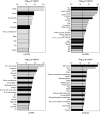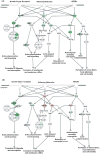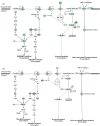Modulation of cell adhesion systems by prenatal nicotine exposure in limbic brain regions of adolescent female rats
- PMID: 20196919
- PMCID: PMC5575906
- DOI: 10.1017/S1461145710000179
Modulation of cell adhesion systems by prenatal nicotine exposure in limbic brain regions of adolescent female rats
Abstract
Maternal smoking during pregnancy (MS) has long-lasting neurobehavioural effects on the offspring. Many MS-associated psychiatric disorders begin or change symptomatology during adolescence, a period of continuous development of the central nervous system. However, the underlying molecular mechanisms are largely unknown. Given that cell adhesion molecules (CAMs) modulate various neurotransmitter systems and are associated with many psychiatric disorders, we hypothesize that CAMs are altered by prenatal treatment of nicotine, the major psychoactive component in tobacco, in adolescent brains. Pregnant Sprague-Dawley rats were treated with nicotine (3 mg/kg.d) or saline via osmotic mini-pumps from gestational days 4 to 18. Female offspring at postnatal day 35 were sacrificed, and several limbic brain regions (the caudate putamen, nucleus accumbens, prefrontal cortex, and amygdala) were dissected for evaluation of gene expression using microarray and quantitative RT-PCR techniques. Various CAMs including neurexin, immunoglobulin, cadherin, and adhesion-GPCR superfamilies, and their intracellular signalling pathways were modified by gestational nicotine treatment (GN). Among the CAM-related pathways, GN has stronger effects on cytoskeleton reorganization pathways than on gene transcription pathways. These effects were highly region dependent, with the caudate putamen showing the greatest vulnerability. Given the important roles of CAMs in neuronal development and synaptic plasticity, our findings suggest that alteration of CAMs contributes to the neurobehavioural deficits associated with MS. Further, our study underscores that low doses of nicotine produce substantial and long-lasting changes in the brain, implying that nicotine replacement therapy during pregnancy may carry many of the same risks to the offspring as MS.
Conflict of interest statement
None.
Figures






Similar articles
-
Gestational nicotine exposure modifies myelin gene expression in the brains of adolescent rats with sex differences.Transl Psychiatry. 2013 Apr 16;3(4):e247. doi: 10.1038/tp.2013.21. Transl Psychiatry. 2013. PMID: 23591971 Free PMC article.
-
Gestational nicotine treatment modulates cell death/survival-related pathways in the brains of adolescent female rats.Int J Neuropsychopharmacol. 2011 Feb;14(1):91-106. doi: 10.1017/S1461145710000416. Epub 2010 Apr 29. Int J Neuropsychopharmacol. 2011. PMID: 20426880
-
Central myelin gene expression during postnatal development in rats exposed to nicotine gestationally.Neurosci Lett. 2013 Oct 11;553:115-20. doi: 10.1016/j.neulet.2013.08.012. Epub 2013 Aug 17. Neurosci Lett. 2013. PMID: 23962570 Free PMC article.
-
Maternal tobacco smoking, nicotine replacement and neurobehavioural development.Acta Paediatr. 2008 Oct;97(10):1331-7. doi: 10.1111/j.1651-2227.2008.00852.x. Epub 2008 Jun 12. Acta Paediatr. 2008. PMID: 18554275 Review.
-
Windows of vulnerability to psychopathology and therapeutic strategy in the adolescent rodent model.Behav Pharmacol. 2004 Sep;15(5-6):341-52. doi: 10.1097/00008877-200409000-00005. Behav Pharmacol. 2004. PMID: 15343057 Review.
Cited by
-
Maternal Smoking during Pregnancy and DNA-Methylation in Children at Age 5.5 Years: Epigenome-Wide-Analysis in the European Childhood Obesity Project (CHOP)-Study.PLoS One. 2016 May 12;11(5):e0155554. doi: 10.1371/journal.pone.0155554. eCollection 2016. PLoS One. 2016. PMID: 27171005 Free PMC article.
-
Modulation Effect of HIV-1 Viral Proteins and Nicotine on Expression of the Immune-Related Genes in Brain of the HIV-1 Transgenic Rats.J Neuroimmune Pharmacol. 2016 Sep;11(3):562-71. doi: 10.1007/s11481-016-9679-4. Epub 2016 May 4. J Neuroimmune Pharmacol. 2016. PMID: 27147085 Free PMC article.
-
Nicotine-like effects of the neonicotinoid insecticides acetamiprid and imidacloprid on cerebellar neurons from neonatal rats.PLoS One. 2012;7(2):e32432. doi: 10.1371/journal.pone.0032432. Epub 2012 Feb 29. PLoS One. 2012. PMID: 22393406 Free PMC article.
-
Identification and characterization of poly(I:C)-induced molecular responses attenuated by nicotine in mouse macrophages.Mol Pharmacol. 2013 Jan;83(1):61-72. doi: 10.1124/mol.112.081497. Epub 2012 Oct 1. Mol Pharmacol. 2013. PMID: 23028093 Free PMC article.
-
Gestational nicotine exposure modifies myelin gene expression in the brains of adolescent rats with sex differences.Transl Psychiatry. 2013 Apr 16;3(4):e247. doi: 10.1038/tp.2013.21. Transl Psychiatry. 2013. PMID: 23591971 Free PMC article.
References
-
- Arikkath J. Regulation of dendrite and spine morphogenesis and plasticity by catenins. Molecular Neurobiology. 2009;40:46–54. - PubMed
-
- Arnsten AF. Catecholamine regulation of the prefrontal cortex. Journal Psychopharmacology. 1997;11:151–162. - PubMed
-
- Batty GD, Der G, Deary IJ. Effect of maternal smoking during pregnancy on offspring’s cognitive ability: empirical evidence for complete confounding in the US national longitudinal survey of youth. Pediatrics. 2006;118:943–950. - PubMed
-
- Benowitz NL, Jacob P., III Daily intake of nicotine during cigarette smoking. Clinical Pharmacology & Therapeutics. 1984;35:499–504. - PubMed
-
- Berendse HW, Galis-de Graaf Y, Groenewegen HJ. Topographical organization and relationship with ventral striatal compartments of prefrontal corticostriatal projections in the rat. Journal of Comparative Neurology. 1992;316:314–347. - PubMed
Publication types
MeSH terms
Substances
Grants and funding
LinkOut - more resources
Full Text Sources

